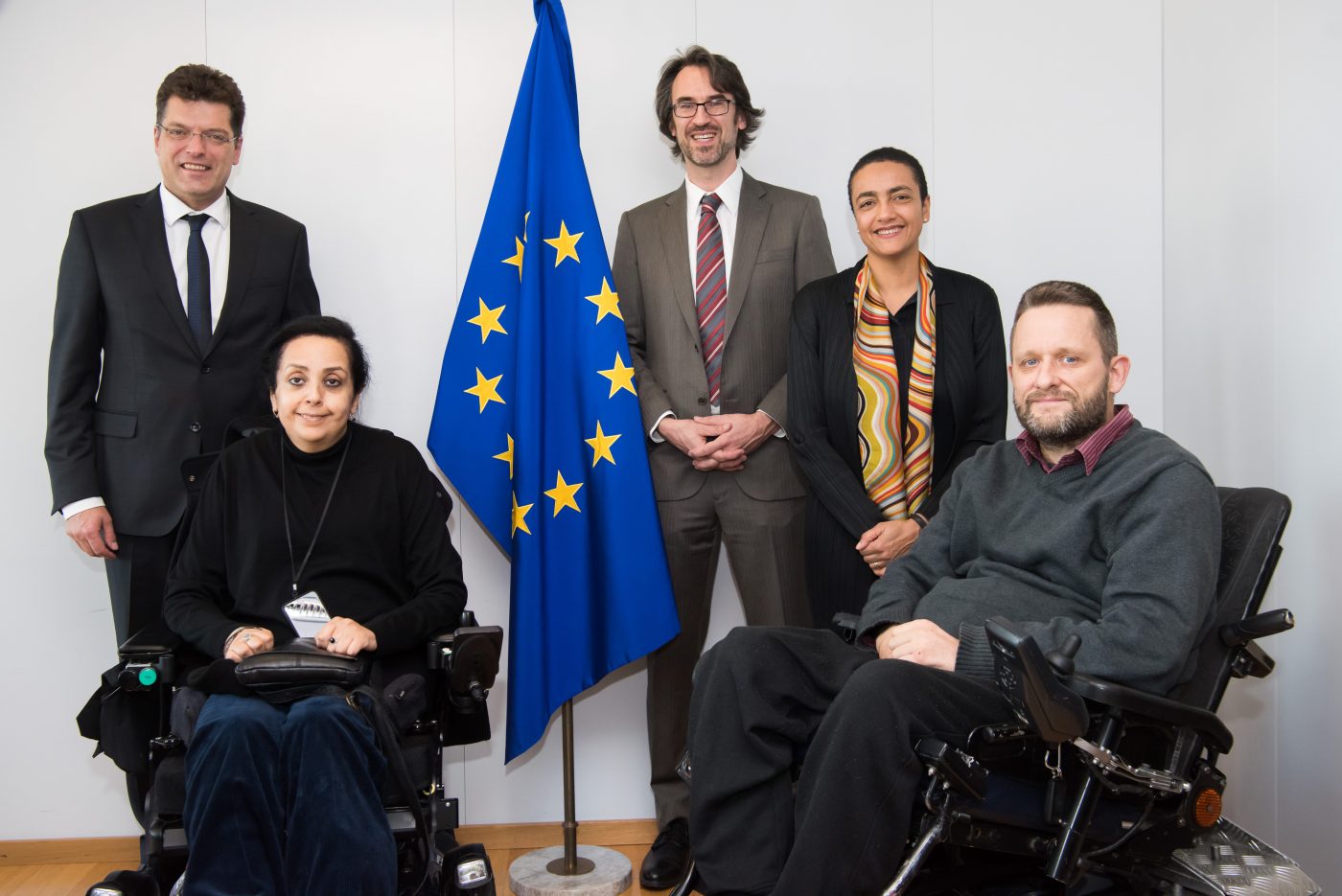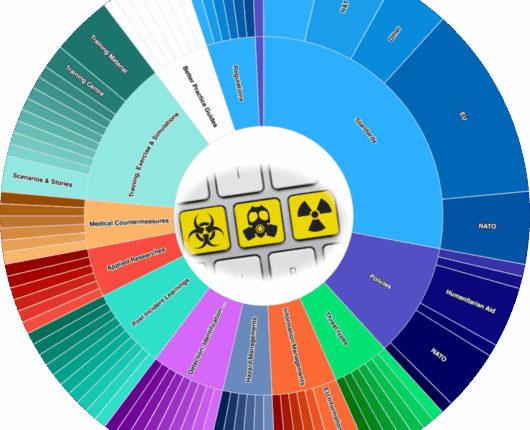DG ECHO Operational Guidance
February 2019
1.1 Introduction: context and purpose of the guidance
It is estimated that on average globally 15% of people have a disability1
, a
proportion which is likely to sharply rise in humanitarian crises. Yet, manners of
delivering assistance and protection to persons with disabilities in humanitarian
settings continue to be insufficiently adapted.
The issue of disability inclusion in
humanitarian settings has gained growing
prominence at global level over the past
years. The United Nations Convention on the
Rights of Persons with Disabilities (CRPD2
)
adopted in 2006, to which the European
Union is a party as well as all the European
Union (EU) Member States3
, provides that
“States Parties shall take, in accordance
with their obligations under international
law, including international humanitarian law and international human rights
law, all necessary measures to ensure the protection and safety of persons with
disabilities in situations of risk, including situations of armed conflict, humanitarian
emergencies and the occurrence of natural disasters” (Art. 11). More recently,
the Charter on Inclusion of Persons with Disabilities in Humanitarian Action (the
Charter)4
launched at the World Humanitarian Summit (WHS) in May 20165
and
endorsed by the European Union was entirely devoted to this question.
At the EU level6, Title II of the Treaty on the functioning of the European
Union (Art. 10) and the EU Charter of Fundamental Rights state that the
European Union shall aim to combat discrimination based on, inter alia, disability
“
The issue of disability inclusion
in humanitarian settings has gained
growing prominence at global level
over the past years.
1 – Including 19.2% females and 12% of males. World Health Organisation (WHO) and the World Bank, World Report on Disability,
Geneva, WHO, 2011, Chapter 2, http://www.who.int/disabilities/world_report/2011/report.pdf
2 – See https://www.un.org/development/desa/disabilities/convention-on-the-rights-of-persons-with-disabilities.html. At the
time of writing, the CRPD has been ratified by 177 countries, and is considered part of the body of IHRL. The optional protocol,
which implies that individuals who have exhausted domestic remedies for discrimination can approach the CRPD committee
for further assistance has been ratified by 92 countries. https://treaties.un.org/Pages/ViewDetails.aspx?src=TREATY&mtdsg_no=IV15&chapter=4&clang=_en retrieved on 28/03/2018.
3 – The CRPD was approved on behalf of the European Community by Council Decision 2010/48/EC of 26.11.2009 and is thus an
integral part of the EU legal order prevailing over EU secondary law.
4 – See http://humanitariandisabilitycharter.org/
5 – This does not negate progress prior to the WHS, such as increased consideration of disability and inclusion in the Sendai
Framework for Disaster Risk Reduction and in the 2030 Agenda on Sustainable Development.
6 – Note that a number of other regional instruments also include provisions for the rights of persons with disabilities, including the
African Charter on Human and Peoples’ Rights (1981, Art. 18.4), the African Charter of the Rights and Welfare of the Child (1990,
Art. 13) and the African Union Convention for the Protection and Assistance of Internally Displaced Persons in Africa (2009, Art.
9.2.C) while the Inter-American Convention on the Elimination of All Forms of Discrimination against Persons with Disabilities is
completely devoted to this issue (adopted 1999; entry into force 2001, retrieved on 29 March 2018).
The Inclusion of Persons with Disabilities in EU-funded Humanitarian Aid Operations
3
(Art. 21)7. Furthermore, article 26 of the Charter of Fundamental Rights states
that the EU recognises and respects the right of persons with disabilities to
benefit from measures designed to ensure their independence, social and
occupational integration and participation in the life of the community. The
European Disability Strategy 2010-2020 calls on the EU and its Member States
to promote the rights of persons with disabilities, including in their external
action8. These obligations and principles are reflected in the Humanitarian Aid
Regulation9 and in the 2007 EU Consensus on Humanitarian Aid10, which both
refer to taking into account specific vulnerabilities, including disability, when
responding to humanitarian needs11.
In order to ensure that these commitments are turned into reality, the European
Commissioner for Humanitarian Aid and Crisis Management, Christos Stylianides,
announced in December 2017 that, as of 2018, all EU-funded humanitarian
partners would be requested to take the needs of persons with disabilities into
account in their projects.
This guidance developed by the European Commission’s humanitarian affairs
department (Directorate-General for European Civil Protection and Humanitarian
Aid Operations – DG ECHO) is conceived as a tool to reach this goal. The main
objectives of this guidance are more specifically:
• To foster disability inclusion, i.e. the effective access and participation of
persons with disabilities12 in humanitarian aid.
• To ensure mainstreaming of disability, i.e. the process of incorporating
protection principles and promoting meaningful access, safety and dignity of
persons with disabilities in all EU-funded humanitarian operations.
• To provide DG ECHO partners13 and DG ECHO staff with the operational tools to
ensure the above in the design, implementation and monitoring of EU-funded
humanitarian projects.
To do so, this guidance builds on international standards and principles already agreed
upon among humanitarian actors, Disabled Peoples’ Organisations (DPOs) and other key
stakeholders, including the CRPD and the Charter. It also draws on existing14 and draft
guidelines under development at the global level, such as the Inter Agency Standing
Committee (IASC) guidelines on inclusion of persons with Disabilities in Humanitarian
Action. As such, this guidance is conceived as a living document that may be revised as
global guidance evolves15. In addition, and critical to its development, this guidance was
also the outcome of several consultations with DPOs and DG ECHO partners.
7 – See https://eur-lex.europa.eu/legal-content/EN/TXT/HTML/?uri=CELEX:12012E/TXT&from=EN and https://eur-lex.europa.eu/legalcontent/EN/TXT/HTML/?uri=CELEX:12012P/TXT&from=EN
8 – Part 2.1, section 8. See http://eur-lex.europa.eu/LexUriServ/LexUriServ.do?uri=COM:2010:0636:FIN:en:PDF,
9 – Council Regulation (EC) No. 1257/96 of June 1996.
10 – Art. 39. See http://ec.europa.eu/echo/files/media/publications/consensus_en.pdf
11 – The 2017 New European Agenda for Development likewise integrates those principles and those included in the 2030 Agenda on
Sustainable Development. In particular, article 31 calls the EU and its Member States to “vigorously promote the rights of persons with
disabilities and take stronger measures to ensure their full inclusion in society and their equal participation in the labour market”. See
https://eur-lex.europa.eu/legal-content/EN/TXT/HTML/?uri=OJ:C:2017:210:FULL&from=EN#ntr1-C_2017210EN.01000101-E0001
12 – Definition inspired by the Advocacy Toolkit for Disability mainstreaming, Africa Disability Alliance, CBM, 2015.
13 – UN, International Organisations and NGOs – by extension the guidance might also be useful to their implementing partners.
14 – At a global level, particularly relevant documents include the Age and Disability Consortium “Humanitarian Inclusion
Standards for Older People and People with Disabilities”, UNICEF Guidelines «Including Children with Disabilities in Humanitarian
Action», CBM «Humanitarian Hands-on Tool», the Age and Disability Consortium “Minimum Standards for Age and Disability
Inclusion in Humanitarian Action”.
15 – The need for this will be reviewed after the publication of the “IASC Guidelines for Inclusion of Persons with Disabilities in
Humanitarian Action” expected in Q2-Q3 2019.
1.2 Scope and format of the guidance
This guidance is in line with the paradigm shift towards a more social and
structural approach to disability inclusion, which recognises persons with
disabilities as rights-holders able to claim their rights. In addition, this guidance
is firmly rooted within the existing framework of protection mainstreaming16,
which is considered crucial to ensure the widest possible uptake amongst
humanitarian actors across all sectors.
Therefore, while it fully acknowledges the
importance of the twin-track approach17, this
guidance concentrates on mainstreaming
the needs of persons with disabilities across
all types of humanitarian interventions,
hence not dealing with targeted actions
specifically18. As such, this guidance is a
complementary tool to existing Thematic
Policies of DG ECHO, in particular to Thematic
Policy n°8 on Humanitarian Protection19.
Whereas existing specialised guidelines
and tools already provide sector specific
recommendations or set minimum
standards, this guidance focuses on the
overall programming level. More specifically, the guidance gives tools to
assess and remove the barriers preventing meaningful access and full and
effective participation of persons with disabilities in humanitarian assistance
and protection. The objective is to lead to better programme quality and better,
safer and more accessible services, assistance and protection for persons with
disabilities in humanitarian operations.
The elements outlined in this guidance are expected to come out clearly in
proposals submitted to DG ECHO with the ultimate purpose of ensuring that
programming takes into account the context-specific needs and priorities of
persons with disabilities.
The guidance consists of three main parts. Part II presents disability
mainstreaming in programming in detail and provides a series of concrete
examples and illustrations. It also provides tools to collect data and measure
disability inclusion. Part III of the guidance is a short (5 pages) document that
that can be easily used in the field for either programming or monitoring. It can
be used as a stand-alone document and read independently of Part II of the
guidance on which it is based.
“
This guidance is in line with the
paradigm shift towards a more social
and structural approach to disability
inclusion, which recognises persons
with disabilities as rights-holders able
to claim their rights.
The Inclusion of Persons with Disabilities in EU-funded Humanitarian Aid Operations 4
16 – See the Inter-Agency Standing Committee (IASC) Policy on Protection in Humanitarian Action (2016) p. 4-5 on http://www.
globalprotectioncluster.org/_assets/files/tools_and_guidance/IASC%20Guidance%20and%20Tools/iasc-policy-on-protection-inhumanitarian-action.pdf
17 – The twin-track approach encompasses both disability-mainstreaming interventions and disability targeted interventions.
See more e.g. in Including Children with Disabilities in Humanitarian Action (p.18), UNICEF, http://training.unicef.org/disability/
emergencies/
18 – Targeting of a specific group in order to respond to specific disability-induced threats and vulnerabilities.
19 – See http://ec.europa.eu/echo/sites/echo-site/files/policy_guidelines_humanitarian_protection_en.pdf
1.3 Definitions and principles
This guidance adopts the definition
of persons with disabilities provided
in the CRPD. The latter acknowledges
that disability is “an evolving
concept” and states that “Persons
with disabilities include those who
have long-term physical, mental,
intellectual or sensory impairments
which in interaction with various
barriers may hinder their full and
effective participation in society on an
equal basis with others” (Art.1).
Impairments are defined as limitations
in body function or structure such as a
significant deviation or loss20.
In humanitarian crisis21 and for the
purpose of this guidance, barriers
are defined as external factors in the
environment in which people live22,
which purposefully or inadvertently
hinder persons with disabilities to fully
access and participate in humanitarian
assistance and protection on an equal
basis with others.
One important example of barrier is
discrimination based on disability (attitudinal barrier), whether of individuals or
groups, discrimination being defined by the CRPD as: “any distinction, exclusion
or restriction on the basis of disability which has the purpose or effect of
impairing or nullifying the recognition, enjoyment or exercise, on an equal basis
with others, of human rights and fundamental freedoms in the political social,
cultural, civil or any other field” (Art. 2).
As is further explained in Part II of this guidance, barriers can be removed,
reduced and their impact mitigated through protective factors and enablers
permitting access to and participation in humanitarian assistance and protection.
Disability inclusion in humanitarian action is based on a series of core principles.
Among them are the principles of dignity and non-discrimination which are
also at the core of the CRPD23. These principles are largely linked with the
humanitarian principles of humanity, impartiality, neutrality and independence,
which are at the core of the EU humanitarian mandate24 as they imply a needsThe Inclusion of Persons with Disabilities in EU-funded Humanitarian Aid Operations
5
20 – It is essential to be aware that common perceptions may lead to provide more attention to certain groups of persons with
disabilities easier to identify and reach out to, against underrepresented and more marginalised groups.
21 – An event or series of events which represent a critical threat to the health, safety, security or well-being of a community or
other large group of people. A humanitarian crisis can have natural or manmade causes, can have a rapid or slow onset and can
be of short or protracted duration.
22 – As per WHO Classification tool: International Classification of Functioning, Disability and Health, see further on http://www.
who.int/classifications/icf/en/.
23 – Inspired by “Understanding the UN Convention on the Rights of Persons with Disabilities”, Marianne Schultze, Handicap
International http://www.internationaldisabilityalliance.org/sites/default/files/documents/hi_crpd_manual2010.pdf
24 – Definition of these principles are included in the terminology in annex 4.2.
© 2018 European Union/
Anouk Delafortrie
The Inclusion of Persons with Disabilities in EU-funded Humanitarian Aid Operations 6
based assistance and upholding the dignity of those we aim to protect and
assist. In effect, all the general principles in article 3 of the CRPD should be
respected as they are all relevant for this area.
The following three CRPD principles are particularly crucial when it comes to
ensuring disability inclusion:
ACCESSIBILITY UNIVERSAL DESIGN REASONABLE
ACCOMMODATION
1. The access of persons with
disabilities, on an equal basis with
others, to the physical environment,
to transportation, to information
and communications, including
information and communications
technologies and systems, and to
other facilities and services open
or provided to the public, both in
urban and in rural areas (based on
CRPD Art. 9).
2. The design of products,
environments, programmes and
services to be usable by all people,
to the greatest extent possible,
without the need for adaptation
or specialised design. Universal
design shall not exclude assistive
devices for particular groups of
persons with disabilities where this
is needed (CRPD Art. 2).
3. Necessary and appropriate
modification and adjustments
not imposing a disproportionate
or undue burden, where needed
in a particular case, to ensure
to persons with disabilities the
enjoyment or exercise on an
equal basis with others of all
human rights and fundamental
freedoms (CRPD Art.2).
© 2018 European Union/Dominique Catton
The Inclusion of Persons with Disabilities in EU-funded Humanitarian Aid Operations
7
- Ensuring Disability
Inclusion in Humanitarian
Operations: Operational
Tools for DG ECHO Partners
and DG ECHO Staf







